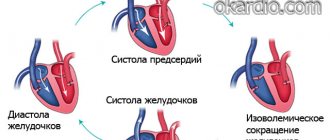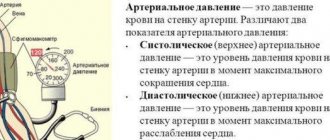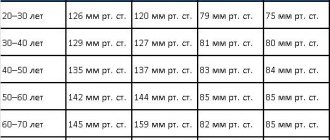Read in this article:
- Two blood pressure readings
- What does the difference between upper and lower pressure mean?
- Reduced diastolic pressure
- High bottom pressure
- Increased systolic pressure
- Reduced upper pressure
- Controlling blood pressure is the key to the health of the whole body
Regularly measuring blood pressure is an important condition for maintaining health. A person may not feel a slight increase or decrease in blood pressure, but such changes indicate negative processes occurring in the body. If measures are not taken in time, there may be a negative effect on the heart and blood vessels, including a heart attack or stroke. This is why it is so important to use a home blood pressure monitor from time to time.
Two blood pressure readings
The device screen displays two parameters, for example, 120/80. They are called upper and lower pressure, scientifically – systolic and diastolic. The first indicates the level of maximum blood pressure on the walls of blood vessels; it is recorded at the moment of contraction of the heart muscle, when blood is pushed out of the heart. The second speaks about the force of blood pressure on the walls of arteries and veins at the moment of complete relaxation of the heart muscle.
Systolic pressure also shows how fast the heart beats. This figure increases with age, so the norm is higher for older people than for young people. Lower blood pressure reflects the force with which blood flows through the vessels. The higher their tone and elasticity, the closer to normal the indicators will be.
The norm is considered to be an upper pressure of 110-130 units (for people over 55 years old - about 140 units), a lower pressure of 65-80 units. The normal difference between them is about 40 units. But the indicators may vary somewhat due to the influence of various factors not related to diseases: emotional or physical stress, time of day and even nutrition.
Forecast
The prognosis is favorable if early treatment is started. The duration of the process is associated with resistance (immunity) to therapy and an unfavorable prognosis.
Everything needs to be done on time before it’s too late. In particularly difficult cases, there is still hope for a complete cure and getting rid of the problem.
Blood pressure with a diastolic reading of 55-60 is hypotension. There is no talk about the norm. The doctor decides how to deal with it, but only after an examination.
It is important not to miss the moment and follow all the recommendations of specialists. You also need to be patient.
What does the difference between upper and lower pressure mean?
If a significant difference between systolic and diastolic pressure appears due to a feeling of hunger, hypothermia, excessive physical activity combined with insufficient nutrition or constant stress, this does not mean that pathology is developing in the body. When the effect of these factors disappears, the indicators may well return to normal, and there will be no cause for concern. But if the gap between the upper and lower pressure remains at rest, this may already indicate disturbances in the functioning of the heart, blood vessels, or other body systems.
A difference of less than 25% of the upper pressure may indicate several pathological conditions:
- Myocarditis;
- Left ventricular stroke;
- Tachycardia;
- Failure of internal organs;
- Aortic stenosis;
- Heart failure;
- Heart attack due to physical overexertion;
- Cardiosclerosis.
Such conditions are often accompanied by symptoms that are difficult to ignore. These are drowsiness and weakness, headache and dizziness, impaired attention and irritability. This situation can result in hypoxia, blurred vision, and sometimes cardiac arrest, so it should never be ignored. Such indicators on the tonometer screen and poor health require medical consultation and examination.
The difference between the upper and lower pressure exceeding 50 units is considered too large. The main causes of this condition are wear and tear and aging of the cardiovascular system. In such cases, tremors of the limbs and dizziness occur, the person becomes irritable or feels complete apathy, and fainting often occurs. Causes may also include pathologies of the digestive organs or gall bladder, and tuberculosis. Only a doctor can establish the true causes and prescribe effective treatment.
Any regular or prolonged deviation of systolic and diastolic pressure from the norm is a reason to pay close attention to your health. And it doesn’t matter whether we are talking about an increase or a decrease - both options can be dangerous.
Symptoms
A person with low diastolic blood pressure may feel dizzy and weak. They may fall more often, which can be especially dangerous for older people.
Low blood pressure usually does not cause any problems. Within certain limits, low blood pressure can be beneficial to your health. Low blood pressure becomes a problem when other symptoms are present, such as:
- dizziness
- fainting
- nausea
- unusual thirst and dehydration
- feeling weak
- blurred vision
- cold, clammy, pale skin
- rapid, shallow breathing
- depression
- palpitations
- headache
Symptoms may go away when you sit or rest. If blood pressure drops too low, the body's vital organs do not receive enough nutrients and oxygen to function properly. This may result in shock. If this occurs, a person should seek medical help immediately.
Reduced diastolic pressure
Low lower pressure is considered to be 50-59 units or less. Such changes indicate a violation of the tone of the vascular wall. When the indicator is less than 50 units, we can talk about a pronounced disturbance of blood flow in the brain, kidneys and other organs.
Diastolic pressure decreases against the background of kidney pathology, for example, Gitelman and Bartter syndromes. This phenomenon is also typical for people with a congenital disorder in the production of certain hormones, including adrenaline. Such changes are accompanied by fever, muscle weakness, vomiting, cramps and abdominal pain.
The first thing to do in such a situation is to consult a doctor. For diagnostic purposes, blood pressure monitoring and examinations are carried out to exclude endocrine pathologies and heart diseases. To increase lower blood pressure, special medications are used.
Prevention
Given that age can be a major cause of low diastolic blood pressure, it is not always possible for a person to prevent it. However, maintaining a healthy weight, eating a balanced diet, and exercising regularly can keep your blood pressure levels stable and also keep your heart healthy.
Lifestyle changes can help people with low diastolic blood pressure, including:
- to give up smoking
- reducing alcohol consumption
- eating small portions of food
- drinking more water
- avoidance of sitting or standing still for long periods of time
- getting up slowly after sitting or lying down
High bottom pressure
The cause of high lower pressure is usually impaired elasticity of blood vessels, their spasms or narrowing of the lumen due to accumulated cholesterol. An increased rate is recorded when:
- Kidney pathologies;
- Malfunctions of the adrenal glands;
- Vascular diseases;
- Impaired blood flow;
- Metabolic disorders;
- Overfatigue (physical or mental).
The cause may also be long-term use of certain medications. The doctor’s primary task is to identify the cause of the changes, and only then prescribe treatment. By the way, lower pressure can increase under the influence of external factors, for example, frequent stress, which causes the release of adrenaline and constriction of blood vessels, bad habits that deplete the heart muscle, poor nutrition, which contributes to the accumulation of cholesterol in the blood vessels and the accumulation of excess weight.
How to treat the condition
Treatment is etiological, aimed at eliminating the root cause of the pathological process. Without knowing a specific diagnosis, it is impossible to say anything about the methods.
Both conservative and surgical methods for correcting the condition are used. Symptomatic therapy is also carried out to eliminate manifestations. It consists of taking tonic drugs in strictly limited dosages.
A radical change in lifestyle is expected: giving up bad habits, normalizing diet and nutrition, using physical therapy methods, etc.
Increased systolic pressure
High upper pressure is a sign of:
- Overactive thyroid gland (thyrotoxicosis);
- Severe anemia;
- Bradycardia (decreased heart rate);
- Aortic valve insufficiency;
- Reduced elasticity and increased density of the vascular wall (for example, atherosclerosis of the aorta).
This condition is called isolated systolic hypertension or systolic hypertension. Upper blood pressure often increases during adolescence. This is due to hormonal changes in the body and is not considered a deviation. With the completion of puberty, the indicators return to normal. True, such changes increase the chances of developing hypertension in adulthood.
Treatment of systolic hypertension is generally similar to those taken for normal hypertension. This also applies to prevention. The main thing is to identify the disease in time, regularly monitor your blood pressure and take medications prescribed by your doctor, including those that help lower blood pressure. In addition, you need a diet, adequate physical activity, and protection from stress.
Reduced upper pressure
Low upper pressure may be associated with lifestyle or illness. In the first case, we are talking about constant overwork and systematic stress, lack of sleep and excessive physical activity. As for pathologies, a decrease in systolic pressure is caused by:
- Thyroid diseases, hormonal imbalances;
- Diabetes;
- Vegetovascular dystonia;
- Arrhythmia;
- Heart failure.
The cause may be prolonged depression. In any case, to normalize the pressure, you need to consult a doctor and identify the factors that contributed to the decrease in pressure. Usually the doctor recommends mainly preventive measures such as strong tea, contrast showers, and healthy sleep. But in some cases, drug treatment is required.
Controlling blood pressure is the key to the health of the whole body
Blood pressure is a common name for two indicators: systolic (upper) and diastolic (lower). If any of them goes beyond the normal range, as well as an excessively large or very small difference between the indicators, they can be symptoms of various diseases. In order not to miss the onset of pathology and take timely measures, it is necessary to regularly measure blood pressure and consult a doctor if the measurement results do not correspond to the norm.
Diagnostics
To determine whether a person has low diastolic blood pressure, the doctor will use a blood pressure monitor. Diastolic value is below 60 mm Hg. is low. Your doctor may do additional tests to determine the cause of your low blood pressure:
- blood or urine tests
- electrocardiogram to read the electrical signals of the heart to determine the rhythm and any abnormalities
- echocardiogram to show detailed images of the heart
- a stress test in which a person undergoes heart monitoring while exercising











